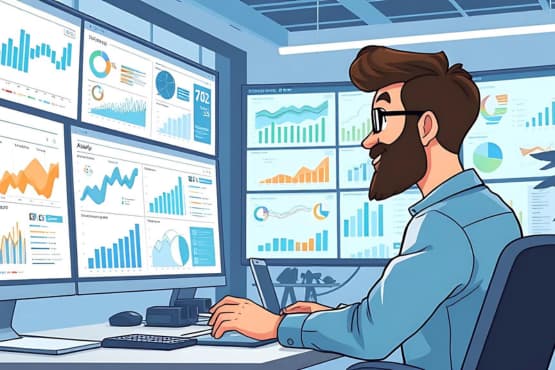The marketing scene is changing fast, and trade marketing is changing too. Trade marketers connect makers and sellers, impacting how products go from factories to stores. Today’s trade marketer needs many skills to work well in real and online markets.
This guide will examine your key skills to succeed in modern trade marketing. We’ll explore the primary abilities, check out the tools of the job, talk about ways to grow your career, and see new trends that are changing the field.
If you’re new to trade marketing or want to improve, this guide will give you valuable ideas to help you do great in this exciting and demanding job.
Core Skills for Trade Marketers
1. Data Analysis and Insights
In a world that runs on data, a trade marketer’s most important skill is their ability to analyze and understand data.
This means more than just working with numbers – finding valuable insights to shape strategy and help make decisions.

Key abilities:
- Interpret complex sales data and market trends
- Use statistical analysis to predict future patterns
- Translate data insights into actionable marketing strategies
- Measure and analyze the ROI of trade marketing activities
Tools and techniques:
- Proficiency in Excel for basic analysis
- Familiarity with advanced analytics platforms like Power BI or Tableau
- Understanding of A/B testing methodologies
- Knowledge of consumer behaviour metrics
Real-world example: A beverage company struggled with flat sales in convenience stores. Analyzing transaction data revealed their products were often purchased as part of a “meal deal” with sandwiches.
They partnered with a famous sandwich brand to create bundled promotions. This data-driven strategy resulted in a 22% increase in sales within the first quarter of implementation.
Practical tip: Start small. Pick one key performance indicator (KPI) in your current role and dive deep into the data behind it. What patterns can you spot? How might these insights inform your strategies?
2. Digital Marketing Proficiency
The line between traditional trade marketing and digital marketing is blurring. Today’s trade marketers must be well-versed in digital strategies to effectively reach retailers and end consumers.
Important areas:
- E-commerce optimization
- Social media marketing and advertising
- Search engine optimization (SEO) and search engine marketing (SEM)
- Content marketing for B2B and B2C audiences
- Email marketing campaigns
Key skills:
- Understanding of major e-commerce platforms (Amazon, Shopify, etc.)
- Ability to create and manage social media campaigns
- Basic web analytics (Google Analytics)
- Familiarity with marketing automation tools
Case study: A small artisanal cheese producer struggled to compete with larger supermarket brands.
They shifted focus to building a solid online presence, creating engaging content about cheese pairings and production methods.
By optimizing their website for local SEO and partnering with food bloggers, they increased online sales by 150% in six months and secured partnerships with high-end restaurants in their region.
Practical exercise: Audit your brand’s digital presence from a retailer’s perspective. Is product information easily accessible?
Are there opportunities to enhance your online product listings or create digital assets that retailers can use?
3. Brand Management and In-Store Marketing
Even as digital channels grow, physical retail remains crucial for many products.
Effective trade marketers excel at bringing their brand to life in stores and creating compelling shopper experiences.

Key responsibilities:
- Develop eye-catching point-of-sale materials and displays
- Ensure brand consistency across all retail touchpoints
- Collaborate with retailers on store layout and product placement
- Create and implement promotional strategies
Skills to develop:
- Visual merchandising techniques
- Understanding of shopper psychology
- Negotiation skills for securing prime shelf space
- Ability to tell brand stories through physical spaces
Example: A premium skincare brand struggled to stand out in crowded beauty aisles. They worked with a major department store to create a “mini-spa” experience within the store, offering free hand massages using their products.
This unique in-store activation increased sales by 35%, leading to a long-term partnership where the brand got dedicated counter space in multiple store locations.
Tip for success: Think beyond the shelf. How can you create memorable experiences that bring your brand values to life in retail?
4. Financial Acumen
Trade marketing often involves significant budgets and directly impacts a company’s bottom line.
A firm grasp of financial principles is essential for making sound decisions and demonstrating the value of trade marketing activities.

Critical skills:
- Understanding of pricing strategies and their impact on margins
- Ability to create and manage budgets for campaigns and promotions
- Proficiency in calculating and interpreting ROI for marketing activities
- Knowledge of trade spend optimization
Key concepts to master:
- Trade promotion effectiveness
- Price elasticity
- Category management principles
- Profit and loss (P&L) analysis
Objective case: A snack food company spent heavily on in-store promotions but saw diminishing returns. A detailed financial analysis revealed that specific promotions lost money when all costs were factored in.
Reallocating their budget to focus on the most profitable promotion types and negotiating better terms with retailers increased their overall ROI on trade spend by 18% while maintaining sales volume.
5. Communication and Relationship Building
Success in trade marketing hinges on building and maintaining strong relationships with stakeholders, from retail buyers to sales teams to brand managers.

How to improve:
- Develop active listening skills
- Practice articulating complex ideas in simple, compelling ways
- Enhance your presentation and public speaking abilities
- Learn the art of storytelling with data
Key relationships to nurture:
- Retail buyers and category managers
- Internal sales and brand teams
- Supply chain partners
- Marketing agencies and other external partners
Success story: A regional dairy brand was losing shelf space to national competitors. Instead of offering more significant trade discounts, their marketing team took a different approach.
They invited key buyers from their top 5 retail partners to visit their farms and production facilities.
This personal touch helped the buyers understand the brand’s commitment to quality and local sourcing.
As a result, they maintained their shelf space and secured premium positioning in the dairy aisle across 70% of their retail partners.
6. Problem-Solving and Creativity
The fast-paced nature of retail means that trade marketers often face unexpected challenges. The ability to think on your feet and develop creative solutions is invaluable.

Approach:
- Develop a structured approach to problem-solving (e.g., the IDEAL method)
- Cultivate creativity through brainstorming techniques and lateral thinking
- Build resilience to handle setbacks and learn from failures
- Stay curious and open to new ideas from various industries
Problem-solving framework:
- Identify the problem clearly
- Define the constraints and available resources
- Explore multiple potential solutions
- Act on the best solution
- Look back and learn from the outcomes
Example: When a popular toy faced production delays just before the holiday season, the trade marketing team had to act fast. Instead of cancelling pre-orders, they created a “Golden Ticket” campaign.
Pre-ordered customers received a beautifully designed promise card (the “Golden Ticket”) and a small branded gift. This not only alleviated disappointed customers but created additional buzz around the product.
When the toy finally hit shelves, it sold out faster than any previous launch, with many attributing its success to the creative handling of the delay.
7. Adaptability and Continuous Learning
The retail landscape is evolving rapidly, with new technologies and changing consumer behaviours constantly reshaping the field.
Successful trade marketers embrace change and commit to ongoing learning.

How to stay adaptable:
- Develop a growth mindset
- Set aside time regularly for learning and skill development
- Stay informed about industry trends and technological advancements
- Be willing to experiment with new approaches and learn from both successes and failures
Areas to watch:
- Emerging retail technologies (e.g., AR, VR, smart shelves)
- Changes in consumer behaviour and preferences
- New retail formats and business models
- Advancements in marketing technology and data analytics
Case in point: When the COVID-19 pandemic hit, a beauty brand known for its in-store makeovers had to pivot quickly.
They rapidly trained their in-store staff to become online beauty consultants, offering virtual makeovers and product recommendations via video chat.
This adaptive approach helped them retain 75% of their expected sales during lockdowns and opened up a new channel for customer engagement that continued to thrive even after stores reopened.
Tools of the Trade
Modern trade marketers rely on digital tools to enhance their effectiveness and efficiency. Familiarity with key software can significantly boost your productivity and insights.

- Data Analysis and Visualization:
- Power BI
- Tableau
- Google Data Studio
- Customer Relationship Management (CRM):
- Salesforce
- HubSpot
- Microsoft Dynamics
- Trade Promotion Management:
- Accenture CAS
- Exceedra
- UpClear
- E-commerce Analytics:
- Profitero
- Edge by Ascential
- Salsify
- Project Management:
- Trello
- Asana
- Monday.com
- Collaboration and Communication:
- Slack
- Microsoft Teams
- Zoom
Tip: While you don’t need to be an expert in all these tools, aim to have a working knowledge of at least one tool in each category. Many offer free trials or training resources – take advantage of these to build your skills.
Real-world application: A trade marketing team used Tableau to create an interactive dashboard of their promotional activities across different retailers.
This visual representation made it easy to spot which promotions were most effective in other regions and store types, leading to more targeted and efficient trade spend.
Professional Development
In a field as dynamic as trade marketing, continuous learning is not just beneficial – it’s essential.

Here are strategies to keep your skills sharp and stay ahead of the curve:
- Formal Education:
- Consider advanced degrees like an MBA with a focus on marketing or supply chain management
- Look into specialized programs in trade marketing or shopper marketing offered by institutions like the Institute of Grocery Distribution (IGD)
- Online Courses and Certifications:
- Platforms like Coursera, edX, and LinkedIn Learning offer courses in various aspects of marketing and data analysis
- Google offers free certifications in digital marketing and analytics
- Category management certifications from organizations like the Category Management Association
- Industry Conferences and Workshops:
- Attend events like the Trade Marketing & Shopper Summit or the Consumer Goods Forum
- Participate in workshops offered by retail associations in your region
- Professional Networks:
- Join organizations like the Path to Purchase Institute or the Institute of Promotional Marketing
- Engage in LinkedIn groups focused on trade marketing and retail
- Stay Informed:
- Subscribe to publications like RetailWire, StoreBrands, or The Shopper Technology Institute
- Follow thought leaders in the field on social media
- Set up Google Alerts for key terms relevant to your industry and role
Real-life example: A mid-level trade marketer took an online course in Python programming for data analysis.
She automated several reporting processes using her new skills, saving her team 10 hours weekly and providing more timely insights to retail partners.
This initiative promoted her to a senior role overseeing digital trade marketing strategy.
Final Thoughts
The field of trade marketing is evolving rapidly, driven by technological advancements, changing consumer behaviours, and shifts in the retail landscape. Modern trade marketers must continually hone their skills and adapt to new challenges to thrive in this dynamic environment.
You can position yourself as a valuable asset in trade marketing by developing core competencies like data analysis, digital proficiency, and strategic thinking while staying attuned to emerging trends and technologies.
Remember, the most successful trade marketers are those who never stop learning and aren’t afraid to innovate. Whether you’re just starting or looking to take your career to the next level, there’s always room to grow and improve.
What’s your next move? Consider your current strengths and areas for development. Choose one skill or trend from this guide to focus on in the coming months. Your journey to becoming an exceptional trade marketer is an ongoing process – embrace the challenge and enjoy the ride!




